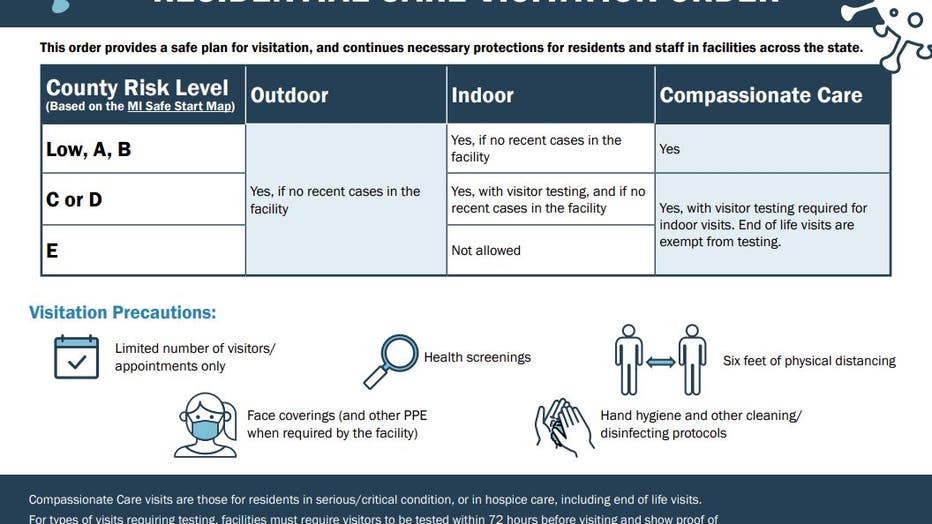Michigan to allow indoor visits at longterm care facilities for first time during COVID-19 pandemic
SOUTHFIELD, Mich. (FOX 2) - The Michigan Department of Health and Human Services (MDHHS) issued an emergency order requiring residential care facilities to allow indoor visitation, depending on the severity of COVID-19 cases and the positivity rate in each county.
Included in the order are limits to communal dining and group activities and requires a notification if an employee or resident tests positive for COVID-19.

Michigan eases restrictions on visitations at long-term care facilities
As the weather turns cooler, Michigan is easing restrictions on indoor visiting at longterm care facilities as long as cases per million stay low enough.
Under the order, visitations are linked to the risk level of each county the facility is in. Indoor visitation will be allowed in areas where the current risk level is A, B, C, or D, so long as the facilities have had no new cases, including those involving residents or staff, originating within the prior 14 days.
If a county is at risk level E, which means there is an elevated incidence growth rate with average daily cases per million over 150 or a positivity rate higher than 20, indoor visitation is not allowed in that county. It is also not allowed if the local health department has made a determination that it would be unsafe.
Currently, only counties in the Upper Peninsula are in the E risk level while all other counties are in A through D.
To view exactly where your county sits in terms of risk level, the state has every county listed with the risk level here.
Outdoor visitation is allowed throughout the state so long as the facility assures that the outdoor visitation area allows for at least six feet between all persons and adequate protection from weather elements is provided.

Michigan has issued an epidemic order allowing indoor visitation at long-term care facilities for the first time since March.
Visitors must wear a facemask at all times in the facility and maintain six-feet social distance from residents.
Visitors who are providing support for Activities of Daily Living (ADLs), medical services, or non-medical services requiring physical contact are not expected to abide by social distance requirements between the visitor and the resident while providing services.
Visitors participating in visits at the end of life may have physical contact with a resident if that resident is not COVID-19 positive, the visitors are wearing appropriate PPE and the time spent within six feet of the resident is no longer than 15 minutes.
“This is a delicate balance of trying to prevent the further spread of the virus while still allowing for family members and friends to visit their loved ones in residential care facilities,” said Dr. Joneigh Khaldun, chief medical executive and chief deputy for health at MDHHS. “I remain concerned about the increase in case levels across the state, so it will be vitally important that the order be followed closely in order to keep the facilities safe and prevent the spread of the virus.”
Visits will be set by appointment only and facilities may impose time limits on visits. Visitors must also notify the facility if they have COVID-19 symptoms within 14 days after visiting.
The number of visitors allowed will be limited to two people at maximum. A health evaluation of all visitors will be required to enter the facility, including tests for fever, and facilities must restrict anyone with fever, symptoms or known exposure from entering the facility.
Julie Beckert assistant vice president, marketing communications ProMedica Senior Care and Foundations, released a statement on the announcement:
"Today’s announcement by the governor is a significant step forward in achieving our shared goal of reuniting patients and residents with their loved ones. We know families are looking forward to being reconnected with their loved one in person and we look forward to returning some sense of normalcy to our center so our residents can once again experience it as the place they know as their home. We are in the process of putting the policies in place to reopen safely to visitors based on CMS and the state's guidance and will communicate those procedures with family members.
"We are currently working to implement appropriate policies to ensure the safest environment and visit as possible. These policies will include, among other items: • Meeting required guidelines • Precautionary infection control measures • Visitor screening measures (which may require testing) • Visitor mask requirements • A process to schedule visits
"Our focus remains on keeping our patients, residents, visitors and employees safe from the virus, which has been our number one priority since this pandemic began. We appreciate everyone’s patience and understanding as we work as quickly as possible to meet state and CMS requirements."

